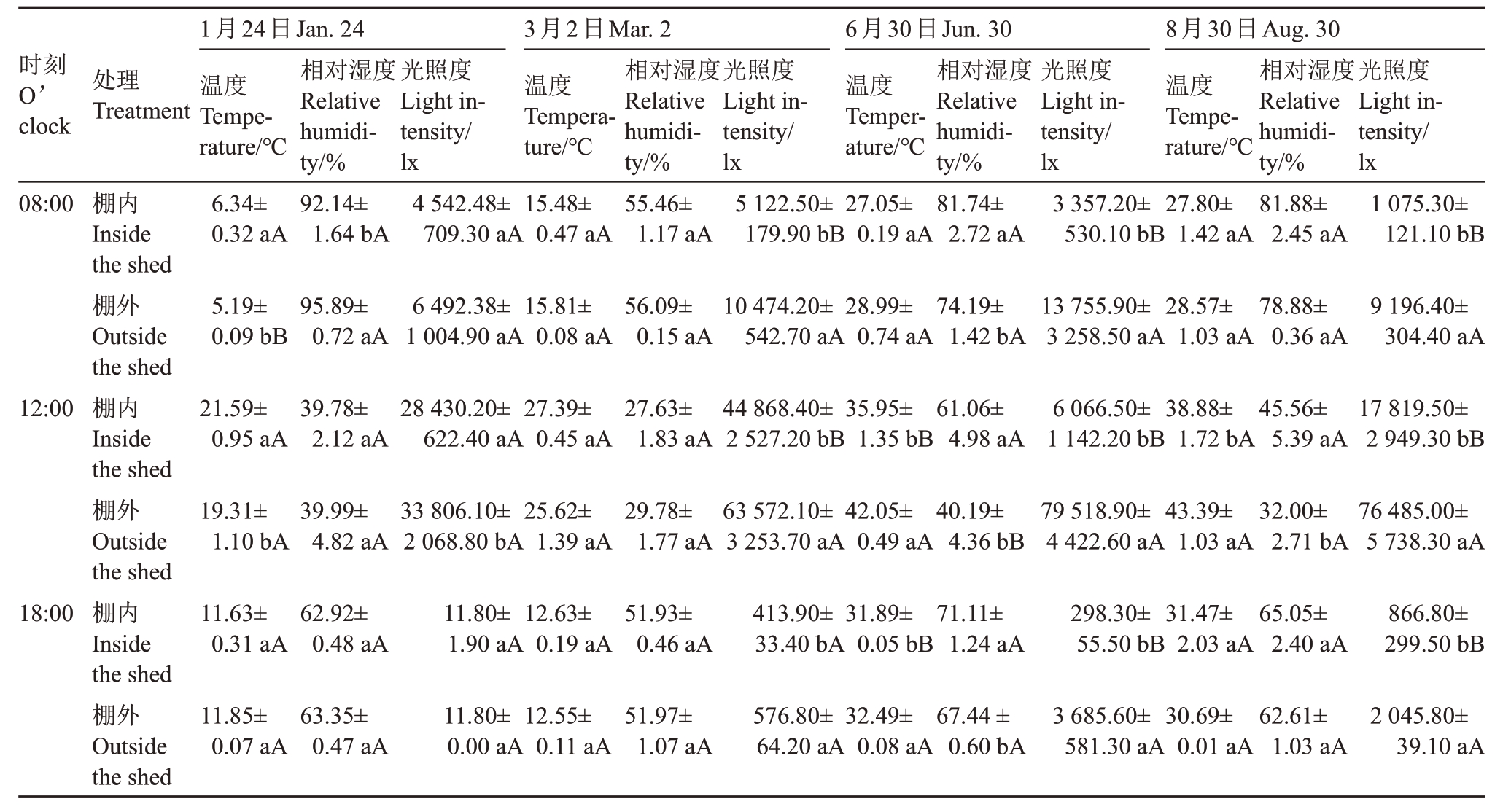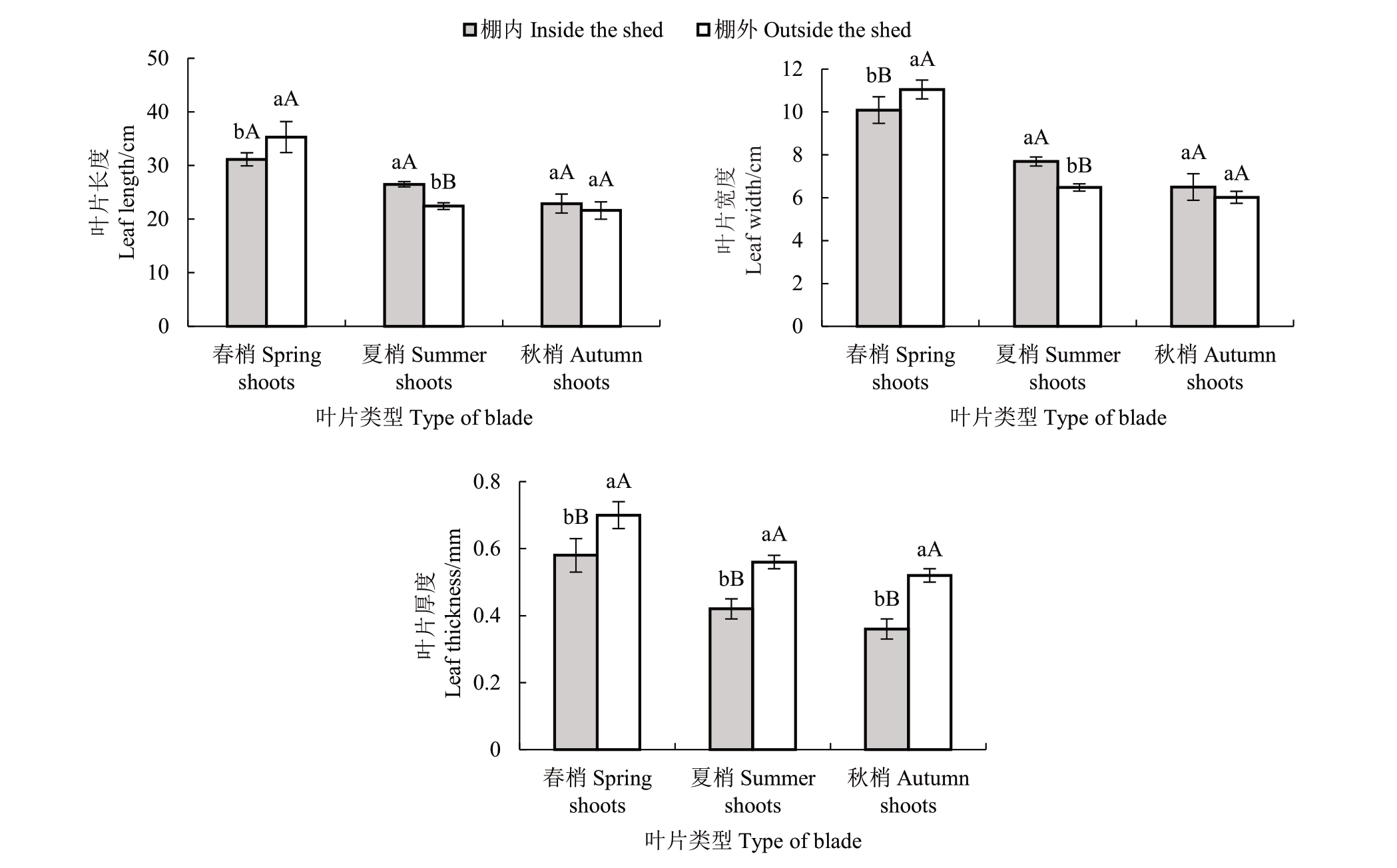枇杷[Eriobotrya japonica (Thunb.) Lindl.]是我国南方特色常绿果树,其果肉柔软多汁、酸甜适口,是深受消费者喜爱的“早春第一果”。枇杷秋冬开花、春末夏初成熟,露地栽培的枇杷在果实膨大期和转色期遇晴雨交替、高温等异常气候时发生裂果[1]、日灼[2]等生理性病害,在夏梢抽生期常因强光、高温影响枝梢生长[3]。采用避雨设施栽培或树冠覆盖可避雨、遮阴防强光,是解决裂果、日灼等枇杷产业问题的有效途径。避雨棚膜能缓解“光合午休”,增强光合能力,有利于植株生长发育[4]。枇杷夏季树冠遮阴[5]、果实发育期避雨设施栽培[6]等,改善了生长环境,达到提高品质与产量、调节产期的效果。但设施栽培前期投入较大,要3~5 a(年)才可收回成本[7],制约了枇杷设施栽培模式的推广。
近年来,避雨设施栽培在葡萄上的应用越来越广,以福建为例,2013年福建省葡萄种植面积8074 hm2,其中设施栽培面积776.33 hm2[7]。立体高效栽培是当前葡萄设施栽培的一个重要方向,可充分利用设施大棚内的有限空间,提高单位面积产量,获取更高的经济效益[8]。水平棚架避雨栽培是福建葡萄设施栽培的主要种植模式[9]。水平棚架下有适合枇杷生长的空间,探讨利用现有葡萄栽培设施发展“避雨设施葡萄-枇杷”套种模式具有重要的产业意义。
在枇杷花芽分化期利用遮阳网适度遮阴可明显降低树冠内部与地下的温度,有利于枇杷枝叶生长、提高枝梢抽穗率[5,10],也可促进枇杷弱枝的花期提前[10]。夏季是葡萄生长成熟期,枝、叶生长量大,此时正是枇杷夏、秋梢生长、花芽分化期,如过度荫蔽会影响叶片光合产物累积,导致枇杷果实品质下降[10-11],长时间重度荫蔽会造成落叶,甚至植株死亡[11];12 月至翌年5 月是葡萄落叶冬眠至萌芽开花时期,其间棚架下光照充足、无遮阴,正是枇杷开花结果、生长发育和成熟期,有利于枇杷果实生长。因此,枇杷与葡萄的物候期可以互补,生产操作互不影响,台湾地区已有在棚架葡萄下套种枇杷的研究报道[10]。枇杷夏梢生长期、果实发育中后期受到短期、单一荫蔽胁迫的影响已有报道,但枇杷在套种环境中受到持续、动态荫蔽,对树体生长和开花结果的影响尚不明确,避雨设施葡萄套种枇杷的可行性尚未可知。为此,笔者利用葡萄水平棚架避雨栽培的动态荫蔽环境,研究避雨棚架及葡萄生长对套种枇杷树体生长、枝叶质量、成花质量、果实病虫害和产量的影响,为探讨避雨栽培葡萄下套种枇杷种植模式的可行性提供参考依据。
1 材料和方法
1.1 试验材料与试验设计
试验连续2 a 在福建省农业科学院果树研究所葡萄、杨梅基地进行(福建省福州市),以避雨栽培葡萄下套种盆栽枇杷为处理,露地盆栽枇杷为对照。试验区避雨设施栽培葡萄为镀锌钢管连栋拱形大棚,单跨宽度为8.0 m,棚顶距地面高度4.0 m,肩高度2.5 m,大棚顶部常年覆盖的流滴膜已使用3 a,透光率87.0%~97.0%,边膜除冬季低温期封闭外均为开放状态;葡萄水平棚架高度2.0 m;棚内种植的葡萄品种为桂葡1号,根域限制栽培模式,树龄5 a,株距2.0 m,行距8.0 m,“一字形”整形,葡萄3月中旬发芽,4 月底—5 月初满架,12 月上旬落叶,12 月底修剪。桂葡1 号葡萄树生长旺盛,在开花结果期间没有修剪徒长枝和过密枝。试验用的枇杷品种为新白8 号,选择树体大小和树势相近、带花蕾的3 年生嫁接大苗18 株,移植在直径60 cm、高度40 cm 的无纺布营养袋内(图1-A)。枇杷树高度150 cm,冠径140 cm,干周15 cm,枝梢数10~13个。枇杷试验树9株置于棚内2 行葡萄树之间,枇杷间的株距2.0 m,与葡萄主干的行距2.0 m;露地对照试验树9株置于距避雨葡萄棚外10.0 m远的露地上,株距2.0 m。3株为1个试验小区,3次重复。每株试验树的树盘上均放置1个滴灌头,根据枇杷物候期及土壤湿度,设置一致的滴灌时间和滴灌量。试验第1年处理区和对照区均未疏花疏果,获得的穗质量、穗粒数、单果质量等为自然坐果数据(图1-B);试验第2年正常疏花疏果,根据结果枝生长情况选留4~6 粒·穗-1(图1-C);试验树其余修剪、套袋、施肥和病虫害防治等均按大田常规管理。

图1 避雨设施葡萄套种的枇杷生长结果情况
Fig.1 Growth and fruiting of potted loquat interplanted under the grapes grown in shelter facilities
A.套种带花穗盆栽枇杷;B.第1 年结果树;C.第2 年结果树。
A.Interplanted potted loquat with flowers;B.1st year fruiting trees;C.2st year fruiting trees.
1.2 测定内容和方法
1.2.1 田间调查与果实品质分析 参照《农作物种质资源鉴定技术规程 枇杷》[12],分别于2017 年和2018年5月、8月、11月枇杷的春梢、夏梢、秋梢叶片成熟时测量叶片的长度、宽度、厚度;于每年11月调查枇杷的冠幅、树高度、干周、叶幕层厚、枝梢数、花穗数等,并测量1 年生枝梢长度(夏梢+秋梢)、夏梢粗度和花穗大小,统计枝梢抽穗率。
每年4月底—5月初枇杷果实成熟时,调查单株果穗数,测定单株产量,按试验小区每株采集成熟果穗各4 穗,测定穗质量,并调查果实病虫害情况;每试验小区随机选取成熟果实各20 粒,测定单果质量、果肉厚度、果肉硬度和可溶性固形物含量,并统计可食率和单株产量。用精度0.01 g电子天平称量单果质量,用精度0.01 mm 电子游标卡尺测量果肉厚度,用GY-3 型水果硬度计测定果肉硬度,用SRAP测糖仪测定可溶性固形物含量。
1.2.2 微生态环境测定 于葡萄冬剪/枇杷幼果滞长期(1月24日)、葡萄萌芽/枇杷幼果迅速膨大期(3月2 日)、葡萄满架/枇杷夏梢生长期(6 月30 日)、葡萄采果后/枇杷花芽生理分化期(8月30日),分别在试验区和对照区各用3台美国HOBO U12-012温湿光度记录仪,同步测定树冠外围的光照度、温度和相对湿度,测定期为08:00—18:00,每1 h 测定1 次;选择08:00、12:00 和18:00 共3 个时间点分析棚内葡萄架下枇杷和棚外枇杷的环境参数。
1.3 统计分析
数据用Excel 2007 进行基础统计和作图,采用DPS 6.5 软件进行数据分析。
2 结果与分析
2.1 避雨设施葡萄对套种枇杷环境因子的影响
由表1 可知,在1 月24 日(葡萄冬剪/枇杷幼果滞长期),08:00 棚内的温度极显著高于棚外,相对湿度显著低于棚外,光照度是棚外的69.97%;12:00和18:00 棚内与棚外的相对湿度差异不显著,12:00的光照度较棚外低15.90%、温度高2.28 ℃,说明了冬季的避雨设施在夜间有保温、白天有增温作用。3 月2 日(葡萄萌芽/枇杷幼果迅速膨大期),棚内处理08:00、12:00 和18:00 的光照度分别较棚外低51.09%、29.42%和28.42%,温度、相对湿度与棚外差异不显著。6 月30 日(葡萄满架/枇杷夏梢生长期),除了08:00 温度差异不显著外,棚内的温度、相对湿度和光照度均与棚外存在显著或极显著差异,12:00 温度较棚外降低6.10 ℃、相对湿度提高20.87%,3 个时间点光照度分别降低了75.59%、92.37%、91.91%。8 月30 日(葡萄采果后/枇杷花芽生理分化期间),棚内3 个测定时间的光照度分别较棚外降低88.31%、76.70%、57.63%,12:00 的温度低于棚外4.51 ℃、相对湿度增加13.56%。避雨棚架及葡萄生长均造成光照度不同程度降低,但不同时期的降低幅度不同。其中,葡萄满架/枇杷夏梢生长期影响最大,该期间的温度和相对湿度也受到显著影响,其次是葡萄采果后/枇杷花芽生理分化期,而葡萄冬剪/枇杷幼果滞长期光照度受到的影响最小,其温度反而较对照提高。这说明避雨设施栽培葡萄冬季有增温作用,夏季有降温增湿效果。
表1 避雨设施葡萄下套种与露地栽培枇杷的差异
Table 1 Differences in the micro-ecological environment of potted loquat interplanted under the grapes grown in shelter facilities and in the open air

注:同列不同大小写字母分别表示与对照间差异极显著(p<0.01)和显著(p<0.05)。下同。
Note: Different capital and small letters in the same column indicate highly significant (p<0.01) and significant (p<0.05) differences from the control respectively.The same below.
时刻O’clock处理Treatment 08:00 1月24日Jan.24温度Temperature/℃6.34±0.32 aA相对湿度Relative humidity/%92.14±1.64 bA棚内Inside the shed棚外Outside the shed棚内Inside the shed棚外Outside the shed棚内Inside the shed棚外Outside the shed光照度Light intensity/lx 4 542.48±709.30 aA 3月2日Mar.2温度Temperature/℃15.48±0.47 aA相对湿度Relative humidity/%55.46±1.17 aA光照度Light intensity/lx 5 122.50±179.90 bB 6月30日Jun.30温度Temperature/℃27.05±0.19 aA相对湿度Relative humidity/%81.74±2.72 aA光照度Light intensity/lx 3 357.20±530.10 bB 8月30日Aug.30温度Temperature/℃27.80±1.42 aA相对湿度Relative humidity/%81.88±2.45 aA光照度Light intensity/lx 1 075.30±121.10 bB 5.19±0.09 bB 95.89±0.72 aA 6 492.38±1 004.90 aA 15.81±0.08 aA 56.09±0.15 aA 10 474.20±542.70 aA 28.99±0.74 aA 74.19±1.42 bA 13 755.90±3 258.50 aA 28.57±1.03 aA 78.88±0.36 aA 9 196.40±304.40 aA 12:00 21.59±0.95 aA 39.78±2.12 aA 28 430.20±622.40 aA 27.39±0.45 aA 27.63±1.83 aA 44 868.40±2 527.20 bB 35.95±1.35 bB 61.06±4.98 aA 6 066.50±1 142.20 bB 38.88±1.72 bA 45.56±5.39 aA 17 819.50±2 949.30 bB 19.31±1.10 bA 39.99±4.82 aA 33 806.10±2 068.80 bA 25.62±1.39 aA 29.78±1.77 aA 63 572.10±3 253.70 aA 42.05±0.49 aA 40.19±4.36 bB 79 518.90±4 422.60 aA 43.39±1.03 aA 32.00±2.71 bA 76 485.00±5 738.30 aA 18:00 11.63±0.31 aA 62.92±0.48 aA 11.80±1.90 aA 12.63±0.19 aA 51.93±0.46 aA 413.90±33.40 bA 31.89±0.05 bB 71.11±1.24 aA 298.30±55.50 bB 31.47±2.03 aA 65.05±2.40 aA 866.80±299.50 bB 11.85±0.07 aA 63.35±0.47 aA 11.80±0.00 aA 12.55±0.11 aA 51.97±1.07 aA 576.80±64.20 aA 32.49±0.08 aA 67.44±0.60 bA 3 685.60±581.30 aA 30.69±0.01 aA 62.61±1.03 aA 2 045.80±39.10 aA
2.2 避雨设施葡萄对套种枇杷树体生长的影响
由表2 可知,试验第1 年避雨设施葡萄下套种盆栽枇杷的枝梢数较棚外少33.80%,差异极显著;冠幅、树高度、叶幕层厚、干周均小于棚外,但差异不显著。试验第2 年,棚内枇杷的树高度、干周、叶幕层厚、枝梢数均极显著小于棚外试验树,其中枝梢数比对照减少63.35%,树高度、干周、叶幕层厚分别降低29.04%、26.40%、44.65%;棚内枇杷的南北冠幅比棚外显著减小。这说明棚内枇杷夏、秋季受葡萄棚架遮阴的影响,枇杷夏梢的侧生枝抽发数量减少,并且影响夏秋梢的生长,使棚内枝梢生长数量减少。
表2 避雨设施葡萄下套种与露地栽培的枇杷树体生长量差异
Table 2 Differences in the growth of potted loquat trees interplanted under the grapes grown in shelter facilities and in the open air

时间Time/a处理Treatment冠幅Crown width/cm 1东西East-west 189.00±18.17 aA南北North-south 155.00±19.15 aA 棚内Inside the shed棚外Outside the shed棚内Inside the shed棚外Outside the shed树高度Height of tree/cm 149.00±12.94 aA干周Trunk girth/cm 12.40±1.14 aA叶幕层厚Thickness of canopy layers/cm 91.00±17.82 aA总枝梢量/(个·株-1)Total number per plant 27.80±2.49 bB 194.80±17.20 aA 171.40±11.30 aA 169.80±17.92 aA 12.50±1.50 aA 107.20±18.62 aA 42.00±7.68 aA 2 234.50±19.98 aA 195.75±34.39 bA 153.75±14.36 bB 12.88±0.85 bB 107.00±23.27 bB 37.50±3.11 bB 247.08±17.68 aA 222.13±11.93 aA 216.67±5.77 aA 17.50±0.50 aA 193.33±37.86 aA 102.33±7.51 aA
2.3 避雨设施葡萄对套种枇杷枝梢生长和成花质量的影响
由表3可知,试验第1年避雨设施葡萄下套种的枇杷枝梢长度、粗度、叶片数和花穗宽度分别比对照低36.30%、17.91%、32.33%和21.86%,差异极显著,花穗长度、花穗数与对照差异显著,枝梢抽穗率与对照差异不显著。试验第2年,套种枇杷的1年生枝梢长度、粗度、叶片数、花穗长度、宽度和花穗数分别是对 照 树 的42.56% 、70.62% 、50.44% 、52.87% 、49.29%、47.06%,差异极显著;枝梢抽穗率与对照差异不显著。这说明了避雨设施栽培葡萄影响套种枇杷的枝梢质量和花穗质量。
表3 避雨设施葡萄下套种与露地栽培的枇杷枝梢质量和成花情况
Table 3 Shoot growth quality and flower conditions of potted loquat interplanted under the grapes grown in shelter facilities and in the open air

时间Time/a处理Treatment花穗数Spike number枝梢抽穗率Flowering rate/%1 1年生枝梢质量Quality of 1-year-old shoots长度Length/cm 11.31±1.55 bB粗度Thickness/mm 9.21±0.72 bB 棚内Inside the shed棚外Outside the shed棚内Inside the shed棚外Outside the shed叶片数Number of blade 14.48±1.53 bB花穗大小Spike size长度Length/cm 11.54±2.93 bA宽度Width/cm 11.08±2.10 bB 5.67±1.15 bA 12.79±10.06 aA 17.84±1.26 aA 11.22±0.66 aA 21.40±2.55 aA 13.55±2.15 aA 14.18±3.43 aA 7.75±0.96 aA 14.89±11.40 aA 2 11.33±2.04 bB 9.23±0.94 bB 12.75±1.15 bB 7.83±1.80 bB 7.33±2.42 bB 6.00±2.08 bB 16.39±5.55 aA 26.62±2.63 aA 13.07±0.75 aA 25.28±2.14 aA 14.81±3.33 aA 14.87±3.29 aA 12.75±3.20 aA 15.17±2.44 aA
2.4 避雨设施葡萄对套种枇杷叶片质量的影响
避雨设施葡萄下套种枇杷的叶片质量差异如图2 所示。棚内枇杷的春梢叶片长度、宽度是棚外的88.24%和91.31%,显著或极显著小于棚外;夏梢的叶片长度、宽度是棚外的1.18倍和1.19倍,差异均达极显著水平,秋梢叶片长度、宽度与对照差异不显著;棚内枇杷的春梢、夏梢、秋梢叶片厚度是棚外的82.86%、75.00%和69.23%,均极显著小于棚外。这说明避雨设施栽培葡萄影响套种枇杷的春梢、夏梢、秋梢叶片质量。

图2 避雨设施葡萄下套种与露地栽培的枇杷叶片质量差异
Fig.2 Differences in the leaf growth quality of potted loquat interplanted under the grapes grown in shelter facilities and in the open air
不同大小写字母分别表示差异极显著(p<0.01)和显著(p<0.05)。
Different capital and small letters indicate extremely significant difference(p<0.01)and significant difference(p<0.05)respectively.
2.5 避雨设施葡萄对套种枇杷果实病虫害的影响
裂果、炭疽病、日灼、虫果等影响枇杷果实的商品性和经济价值。如表4 和图3 所示,试验第1年由于果实生长季雨水较多,避雨设施葡萄下套种枇杷的裂果率、炭疽病果率、日灼果率分别较对照减少16.65%、26.20%、7.93%,未发现皱果和虫果,好果率较对照高27.25%。试验第2 年疏花疏果,果实生长季干旱少雨,套种枇杷的落果率较对照低14.03%,炭疽病果率、皱果率、虫果率、日灼果率分别较对照低14.28%、3.88%、3.04%、3.73%,好果率较对照高12.89%。这说明避雨设施栽培葡萄能有效减少套种枇杷果实病虫害发生,提高枇杷好果率。
表4 避雨设施葡萄下套种与露地栽培的枇杷果实病虫害发生差异
Table 4 Differences in the occurrence of fruit diseases and pests of potted loquat interplanted under the grapes grown in shelter facilities and in the open air

时间Time/a 1 2处理Treatment棚内Inside the shed棚外Outside the shed棚内Inside the shed棚外Outside the shed皱果率Wrinkle rate/%0.00 1.01 4.84 8.72裂果率Fruit cracking rate/%11.63 28.28 3.23 2.91落果率Fruit drop rate/%10.47 9.09 8.06 22.09虫果率Infestation rate/%0.00 2.02 1.61 4.65炭疽病果率Anthrax rate/%8.14 34.34 3.23 11.05日灼果率Sunscald rate/%1.16 9.09 7.56 11.29好果率Good fruit rate/%76.74 49.49 77.42 64.53

图3 避雨设施葡萄下套种与露地栽培的枇杷果实
Fig.3 Fruit of potted loquat interplanted under the grapes grown in shelter facilities and in the open air
A、B 分别为第1 年棚内、棚外果实,C、D 分别为第2 年棚内、棚外果实。
A and B are the 1st year fruit inside and outside the greenhouse;C and D are 2nd year fruit inside and outside the greenhouse.
2.6 避雨设施葡萄对套种枇杷果实质量的影响
如表5所示,试验第1年,在未疏花疏果条件下,棚内枇杷的果穗质量、单株产量分别是棚外的62.72%、69.83%,极显著或显著低于棚外;棚内枇杷的单果质量、可溶性固形物含量分别是棚外的92.25%和90.58%,差异显著;果肉厚度、硬度、可食率与棚外差异不显著。试验第2年,统一疏花疏果,棚内枇杷的果穗质量、单果质量、果肉厚度、可食率与棚外差异均不显著;单株产量、可溶性固形物含量、果肉硬度分别是对照的69.67%、88.80%、84.72%,差异显著。这说明避雨设施栽培葡萄会影响套种枇杷的产量和果实品质。
表5 避雨设施葡萄下套种与露地栽培的枇杷果实质量差异
Table 5 Differences in fruit quality of potted loquat interplaned under the grapes grown in shelter facilities and in the open air

时间Time/a 1果穗质量Ear mass/g 167.19±26.74 bB单株产量Yield per plant/kg 0.81±0.15 bA处理Treatment棚内Inside the shed棚外Outside the shed棚内Inside the shed棚外Outside the shed单果质量Fruit mass/g 42.13±1.29 bA果肉厚度Pulp thickness/mm 10.32±0.30 aA w(可溶性固形物)Soluble solids content/%11.54±0.77 bA果肉硬度Flesh firmness/(kg·cm-2)1.25±0.05 aA可食率Edible rate/%76.74±0.43 aA 266.55±45.00 aA 1.16±0.21 aA 45.67±2.06 aA 10.72±0.22 aA 12.74±0.22 aA 1.24±0.09 aA 74.94±1.71 aA 2 263.20±28.03 aA 1.47±0.15 bA 58.49±2.06 aA 9.52±0.44 aA 10.15±0.20 bA 1.94±0.12 bA 74.53±1.20 aA 272.62±14.88 aA 2.11±0.25 aA 60.61±2.05 aA 9.60±0.57 aA 11.43±0.50 aA 2.29±0.07 aA 72.79±1.06 aA
3 讨 论
3.1 避雨设施葡萄对套种枇杷生长环境的动态影响
已有研究表明,套种、遮阴等造成的荫蔽胁迫会影响光照度、温度和相对湿度,如大棚覆盖的塑料薄膜会降低棚内的光照度[13-14],而对温度的影响因季节、天气而异[14-16];棚内温度随垂直高度的增加而升高[16],相对湿度亦受一定影响[14];遮阳网在夏季遮阴树冠,日平均气温和日平均相对湿度比棚外高,但最高气温、最大相对湿度较棚外低,日最低气温和最低相对湿度较棚外高[6];高位作物会对低位套种作物有荫蔽作用[17],大幅降低光照度,影响温度[18-19],对光质也造成影响,红光与远红光比值降低[20];避雨设施栽培葡萄白天的光照度极显著低于露地,午后的气温显著高于露地、空气湿度显著低于露地[21],在4—5月,棚内温度较棚外高,且气温越高棚内外的温差越大,促进了枇杷果实的生长发育与成熟[7]。本试验中,避雨设施栽培葡萄的无滴膜和葡萄枝叶等共同作用,造成4 个时期中午光照度较对照低15.90%~92.37%,光照度下降幅度为葡萄冬剪/枇杷幼果滞长期<葡萄萌芽/枇杷幼果迅速膨大期<葡萄采果后/枇杷花芽生理分化期<葡萄满架/枇杷夏梢生长期;葡萄冬剪/枇杷幼果滞长期因避雨棚边膜封闭且透光率相对高,导致上午和中午的温度显著高于对照,葡萄满架/枇杷夏梢生长期,葡萄的生长量最大,中午的温度降低、相对湿度提高的幅度最大,葡萄采果后/枇杷花芽生理分化期间,中午的温度对照较大幅度降低、相对湿度提高。已有研究认为,树冠内相对光照度低于30%为无效光区域[22-23],用透光率分别为15%、2.25%遮阳网持续遮阴胁迫下,枇杷落叶严重、干物质含量明显下降[11]。因此在葡萄的年生长周期内,套种区的枇杷经历了“轻(葡萄冬剪期/枇杷幼果滞长期)-中(葡萄萌芽期/枇杷幼果迅速膨大期)-重(葡萄满架果实生长期/枇杷夏梢生长期)-较重(葡萄采果后/枇杷花芽生理分化期)”的持续动态荫蔽胁迫。
3.2 避雨设施葡萄下的动态环境因子变化对枇杷生长的影响
植物的生长发育与光信号密切相关,不同光强和光质影响枝叶生物量、光合生态参数,影响形态建成和物质积累[20,24]。荫蔽胁迫可诱导生长素(indoleacetic acid,IAA)、赤霉素(gibberellins,GA)等参与介导响应,进而影响生长发育状态[25]。荔枝全株遮阴后,新叶的比重显著降低,叶片变得“大而薄”[26],显著降低荔枝枝梢的生长量[27]。但是,在树体恢复期和主花期前期,荫蔽度30%可以促进胡椒叶片的糖积累[28]。枇杷成年树要求较充足的光照,荫蔽严重的树冠会造成内膛郁闭或骨干枝光秃,结果部位外移[3],果实生长发育期持续高强度荫蔽,会造成枇杷叶片变薄、落片,影响干物质积累[11]。本试验中,由于受避雨设施葡萄的长期荫蔽胁迫,棚内套种盆栽枇杷的枝梢数量、枝梢长度、粗度、叶片数均明显减少,而周政华等[5]认为夏季不同遮光率的遮阳网对枇杷新梢的数量、长度、粗度等没有影响。结论不同,可能与本试验遮阴时间长、遮阴强度不同及品种反应不同有关。棚内枇杷种植第2 年的南北冠幅、树高度、干周、叶幕层厚、枝梢数均显著减少,花穗变小、叶片薄但叶面积增大,与周琳耀等[26]研究结果相同,这是因为荫蔽胁迫降低了红光与远红光的比值,有利于植株叶片变大,以增加生物量积累[29]。这说明遮阴强度越大、持续时间越长,越不利于枇杷树体生长。因此,避雨设施栽培葡萄套种枇杷,在夏季葡萄开花结果的生长旺盛期,需加强葡萄的修剪,增加光照,减弱对枇杷夏梢和秋梢生长的遮阴作用,此外还需对葡萄与枇杷的品种进行筛选。
3.3 避雨设施葡萄下的环境因子对枇杷结果的影响
荫蔽胁迫影响作物的光合速率[30-31]、矿质营养积累[26]、坐果率[32]、产量[33]和病害发生[13,32],适度遮阴会提高桃[22]、草莓[34]果实品质。樱桃果实膨大期适度遮阴可降低裂果率、增加单果质量[35]。开花早期遮阴对番茄果实产量影响较小,盛花期重度遮阴使产量降低[36]。本试验中,第1年未疏花疏果,葡萄遮阴显著影响枇杷花穗数、花穗大小、果穗质量、单果质量和单株产量;第2年正常疏花疏果后,棚内枇杷的单株产量较棚外显著减少,对果穗质量、单果质量的影响不显著。这是因为枇杷的结果枝性状与产量关系密切,而持续动态荫蔽胁迫下,光合产物的积累受到影响[11,31],造成枝梢数量与质量下降,进而显著影响枇杷的开花结果,降低产量。果实成熟期覆盖遮阳网[5]、设施栽培[37]可改善生长环境,有效防止裂果,但设施内温度过高会导致果实日灼与皱果[37]。试验第1年,果实生长季雨水较多,避雨设施葡萄下套种盆栽枇杷的裂果率、炭疽病果率、日灼果率明显减少。第2 年干旱少雨,棚内枇杷落果率、炭疽病果率、日灼果率、皱果率显著减少。这表明避雨设施葡萄可减少套种枇杷果实的病虫害,提高好果率。
4 结 论
避雨设施栽培葡萄的生长发育,可动态影响套种区的微生态环境,降低套种枇杷的枝梢、花穗的数量和质量,而套种的枇杷可正常生长、结果,且果实病虫害减少,说明避雨设施栽培葡萄下套种枇杷是一种可行的种植模式,但需进一步研究适宜的配套栽培技术。
致谢:本试验得到本所葡萄和杨梅课题组的试验场地支持,一并致谢!
[1]许奇志,邓朝军,蒋际谋,陈天佑,陈秀萍,郑少泉.枇杷裂果病发生影响因素探讨[J].中国南方果树,2016,45(2):93-96.XU Qizhi,DENG Chaojun,JIANG Jimou,CHEN Tianyou,CHEN Xiuping,ZHENG Shaoquan.Discussion on influencing factors of loquat fruit cracking disease[J].South China Fruits,2016,45(2):93-96.
[2]邓朝军,蒋际谋,张小艳,许奇志,章希娟,魏秀清,郑少泉.枇杷果皮热伤害发生影响因子研究[J].福建农业学报,2012,27(10):1081-1086.DENG Chaojun,JIANG Jimou,ZHANG Xiaoyan,XU Qizhi,ZHANG Xijuan,WEI Xiuqing,ZHENG Shaoquan.Research on influence factors in heat injury of loquat peel[J].Fujian Journal of Agricultural Sciences,2012,27(10):1081-1086.
[3]蒋际谋,陈秀萍.枇杷优质栽培百问百答[M].2 版.北京:中国农业出版社,2009:8.JIANG Jimou,CHEN Xiuping.Questions and answers on quality cultivation of loquat[M].2nd ed.Beijing:China Agriculture Press,2009:8.
[4]李中瀚,刘明慧,唐美玲,郑秋玲,徐鲁成,高振,杜远鹏.避雨棚膜Coverlys TF150®对葡萄植株生长发育及光合特性的影响[J].果树学报,2023,40(6):1171-1179.LI Zhonghan,LIU Minghui,TANG Meiling,ZHENG Qiuling,XU Lucheng,GAO Zhen,DU Yuanpeng.Effects of Coverlys TF150® on the growth and photosynthetic characteristics of grape plants[J].Journal of Fruit Science,2023,40(6):1171-1179.
[5]周政华,文向多,胡小三.树冠遮阴对大五星枇杷生长结果的影响试验[J].现代农业科技,2007(11):6-7.ZHOU Zhenghua,WEN Xiangduo,HU Xiaosan.Effect of crown shading on growth and fruiting of Dawuxing loquat[J].Modern Agricultural Science and Technology,2007(11):6-7.
[6]许晶明.设施栽培对早钟6 号枇杷果实生长的影响[J].福建农业学报,2011,26(6):1142-1145.XU Jingming.Facility for cultivating Zaozhong Ⅵloquat[J].Fujian Journal of Agricultural Sciences,2011,26(6):1142-1145.
[7]颜惠煌,陈旭,邱志鹏,李敏,邱栋梁.福建省葡萄设施栽培现状及发展前景[J].亚热带农业研究,2014,10(4):285-287.YAN Huihuang,CHEN Xu,QIU Zhipeng,LI Min,QIU Dongliang.Current status and prospects of grape protected cultivation in Fujian Province[J].Subtropical Agriculture Research,2014,10(4):285-287.
[8]钟珍梅,刘明香,李振武.设施葡萄立体栽培模式与经济效益分析[J].现代农业科技,2016(10):240,242.ZHONG Zhenmei,LIU Mingxiang,LI Zhenwu.Stereoscopic cultivation mode and economic benefit analysis of facility grape[J].Modern Agricultural Science and Technology,2016(10):240,242.
[9]雷龑,蔡盛华,詹小敏,黄新忠.福建葡萄产业发展现状与对策[J].中外葡萄与葡萄酒,2009(11):73-75.LEI Yan,CAI Shenghua,ZHAN Xiaomin,HUANG Xinzhong.Present situation and countermeasures of grape industry development in Fujian[J].Sino-Overseas Grapevine & Wine,2009(11):73-75.
[10]林嘉兴,张林仁.遮光处理对枇杷产期及品质之影响[J].台中区农业改良场特刊,1994(34):117-126.LIN Jiaxing,ZHANG Linren.Effect of shading treatment on production season and quality of loquat[J].Special Issue of Taichung Agricultural Improvement Farm,1994(34):117-126.
[11]单幼霞.光胁迫对枇杷果实发育期间生理生化的影响[D].杭州:浙江农林大学,2018.SHAN Youxia.The effect of light stress on physiological and biochemical characteristics on loquat during fruit development[D].Hangzhou:Zhejiang A&F University,2018.
[12]中华人民共和国农业部.农作物种质资源鉴定技术规程枇杷:NY/T 1304—2007[S].北京:中国标准出版社,2007.The Ministry of Agriculture of the People’s Republic of China.Technical code for evaluating germplasm resources loquat[Eriobotrya japonica (Thunb.) Lindl.]:NY/T 1304—2007[S].Beijing:Standards Press of China,2007.
[13]栗进朝,段罗顺,张晓申.避雨对葡萄病害和光照度的影响[J].果树学报,2009,26(6):847-850.LI Jinchao,DUAN Luoshun,ZHANG Xiaoshen.Effect of rainproof cultivation on grape disease incidence and light intensity under the shelter[J].Journal of Fruit Science,2009,26(6):847-850.
[14]韩真,李秀杰,张庆田,刘利,李勃.避雨栽培对葡萄叶幕光照度和成本收益的影响[J].山东农业科学,2018,50(11):52-54.HAN Zhen,LI Xiujie,ZHANG Qingtian,LIU Li,LI Bo.Effects of rain-shelter cultivation on light intensity in canopy,cost and benefit[J].Shandong Agricultural Sciences,2018,50(11):52-54.
[15]常萍,吴文莹,吕中伟.葡萄避雨棚内外光照度及温度变化动态研究[J].中国果菜,2016,36(9):31-34.CHANG Ping,WU Wenying,LÜ Zhongwei.Grape rain shed light on the dynamic changes of internal and external strength and temperature[J].China Fruit Vegetable,2016,36(9):31-34.
[16]沈长华,戴琳贵,曹李兴,叶永青,祁敏.南方连栋避雨塑料大棚小气候及其对红提葡萄品质的影响[J].中国农业气象,2009,30(S1):68-72.SHEN Changhua,DAI Lingui,CAO Lixing,YE Yongqing,QI Min.Microclimate of multi-span plastic greenhouse and its impacts on quality of Red Globe grape in southern China[J].Chinese Journal of Agrometeorology,2009,30(S1):68-72.
[17]刘卫国,蒋涛,佘跃辉,杨峰,杨文钰.大豆苗期茎秆对荫蔽胁迫响应的生理机制初探[J].中国油料作物学报,2011,33(2):141-146.LIU Weiguo,JIANG Tao,SHE Yuehui,YANG Feng,YANG Wenyu.Preliminary study on physiological response mechanism of soybean (Glycine max) stem to shade stress at seedling stage[J].Chinese Journal of Oil Crop Sciences,2011,33(2):141-146.
[18]许轲,张洪程,戴其根,霍中洋,张军.稻田套播麦共生期农田生态环境特征及对小麦生长的影响[J].中国农业科学,2008,41(8):2263-2270.XU Ke,ZHANG Hongcheng,DAI Qigen,HUO Zhongyang,ZHANG Jun.Characteristics of farmland eco-environment at interplanting stage of wheat interplanted in paddy and their effects on wheat growth[J].Scientia Agricultura Sinica,2008,41(8):2263-2270.
[19]张保民,张黎黎.麦田套种对玉米环境因子及生长发育影响的研究[J].山东农业大学学报(自然科学版),2008,39(4):495-500.ZHANG Baomin,ZHANG Lili.Wheat field interplantion to corn environment factor and growth growthinfulence research[J].Journal of Shandong Agricultural University (Natural Science Edition),2008,39(4):495-500.
[20]程亚娇,谌俊旭,王仲林,范元芳,陈思宇,李泽林,刘沁林,李中川,杨峰,杨文钰.光强和光质对大豆幼苗形态及光合特性的影响[J].中国农业科学,2018,51(14):2655-2663.CHENG Yajiao,CHEN Junxu,WANG Zhonglin,FAN Yuanfang,CHEN Siyu,LI Zelin,LIU Qinlin,LI Zhongchuan,YANG Feng,YANG Wenyu.Effects of light intensity and light quality on morphological and photosynthetic characteristics of soybean seedlings[J].Scientia Agricultura Sinica,2018,51(14):2655-2663.
[21]曹锰.避雨栽培对葡萄生长小气候及果实品质的影响[D].北京:中国农业科学院,2015.CAO Meng.Rain-shelter cultivation influences microclimate and grape quality[D].Beijing:Chinese Academy of Agricultural Sciences,2015.
[22]何凤梨,王飞,魏钦平,王小伟,张强.桃树冠层相对光照分布与果实产量品质关系的研究[J].中国农业科学,2008,41(2):502-507.HE Fengli,WANG Fei,WEI Qinping,WANG Xiaowei,ZHANG Qiang.Relationship between distribution of relative light intensity in canopy and yield and quality of peach fruit[J].Scientia Agricultura Sinica,2008,41(2):502-507.
[23]WERTHEIM S J,WAGENMAKERS P S,BOOTSMA J H,GROOT M J.Orchard systems for apple and pear:Conditions for success[J].Acta Horticulturae,2001(557):209-227.
[24]YYANG F,WANG X C,LIAO D P,LU F Z,GAO R C,LIU W G,YONG T W,WU X L,DU J B,LIU J,YANG W Y.Yield response to different planting geometries in maize-soybean relay strip intercropping systems[J].Agronomy Journal,2015,107(1):296-304.
[25]帅海威,孟永杰,陈锋,周文冠,罗晓峰,杨文钰,舒凯.植物荫蔽胁迫的激素信号响应[J].植物学报,2018,53(1):139-148.SHUAI Haiwei,MENG Yongjie,CHEN Feng,ZHOU Wenguan,LUO Xiaofeng,YANG Wenyu,SHU Kai.Phytohormone-mediated plant shade responses[J].Chinese Bulletin of Botany,2018,53(1):139-148.
[26]周琳耀,莫伟平,张静逸,黄俊波,贝学文,付欣雨,王惠聪,黄旭明.遮阴对荔枝光合特征及矿质营养积累的影响[J].果树学报,2014,31(2):270-275.ZHOU Linyao,MO Weiping,ZHANG Jingyi,HUANG Junbo,BEI Xuewen,FU Xinyu,WANG Huicong,HUANG Xuming.Effects of shading on photosynthetic characteristics and mineral nutrition in Litchi[J].Journal of Fruit Science,2014,31(2):270-275.
[27]HIEKE S,MENZEL C M,LÜDDERS P.Effects of light availability on leaf gas exchange and expansion in lychee(Litchi chinensis)[J].Tree Physiology,2002,22(17):1249-1256.
[28]祖超,杨建峰,李志刚,王灿,鱼欢,邬华松.遮阴对胡椒主花期叶片碳代谢及成花量的影响[J].热带作物学报,2015,36(9):1561-1567.ZU Chao,YANG Jianfeng,LI Zhigang,WANG Can,YU Huan,WU Huasong.Effect of shading on carbon metabolism and inflorescence quantity in black pepper during full-bloom stage[J].Chinese Journal of Tropical Crops,2015,36(9):1561-1567.
[29]PARK Y,RUNKLE E S.Far-red radiation promotes growth of seedlings by increasing leaf expansion and whole-plant net assimilation[J].Environmental and Experimental Botany,2017,136:41-49.
[30]陈延松,袁华玲,卫文渊,刘思芹,陈加伟,姚成林.夏季遮阳对‘红阳’猕猴桃净光合速率的影响及其与生理生态因子的关系[J].果树学报,2017,34(9):1144-1151.CHEN Yansong,YUAN Hualing,WEI Wenyuan,LIU Siqin,CHEN Jiawei,YAO Chenglin.Impact of summer shading on net photosynthetic rate of Actinidia chinensis’Hongyang’and its related eco- physiological factors[J].Journal of Fruit Science,2017,34(9):1144-1151.
[31]莫伟平,周琳耀,张静逸,黄俊波,贝学文,付欣雨,王惠聪,黄旭明.遮阴和环剥对荔枝枝梢生长和光合生理的影响[J].园艺学报,2013,40(1):117-124.MO Weiping,ZHOU Linyao,ZHANG Jingyi,HUANG Junbo,BEI Xuewen,FU Xinyu,WANG Huicong,HUANG Xuming.Effects of shading and girdling on shoot growth and photosynthesis in Litchi[J].Acta Horticulturae Sinica,2013,40(1):117-124.
[32]陶丽,倪书邦,贺熙勇,陈丽兰,陈国云,肖高中.遮阴对澳洲坚果树干日灼、生长及座果的影响[J].热带农业科技,2004,27(2):7-9.TAO Li,NI Shubang,HE Xiyong,CHEN Lilan,CHEN Guoyun,XIAO Gaozhong.Effect of shading on Sun burn,growth and fruit setting of macadamia[J].Tropical Agricultural Science&Technology,2004,27(2):7-9.
[33]刘贤赵,康绍忠.番茄不同生育阶段遮阴对光合作用与产量的影响[J].园艺学报,2002,29(5):427-432.LIU Xianzhao,KANG Shaozhong.Effects of shading on photosynthesis and yield of tomato plants at different growth stages[J].Acta Horticulturae Sinica,2002,29(5):427-432.
[34]彭鑫,王喜乐,倪彬彬,陈思兰,叶超琳,胡君艳,左照江.遮阴对草莓光合特性和果实品质的影响[J].果树学报,2018,35(9):1087-1097.PENG Xin,WANG Xile,NI Binbin,CHEN Silan,YE Chaolin,HU Junyan,ZUO Zhaojiang.Effects of shading on photosynthetic characteristics and fruit quality in strawberry[J].Journal of Fruit Science,2018,35(9):1087-1097.
[35]曹甲,黄宗兴,刘珠琴.遮阳处理对中国樱桃果实品质的影响[J].园艺与种苗,2017,37(8):44-45.CAO Jia,HUANG Zongxing,LIU Zhuqin.Effects of shading treatment on Chinese cherry fruit quality[J].Horticulture&Seed,2017,37(8):44-45.
[36]刘贤赵,康绍忠.不同生长阶段遮阴对番茄光合作用、干物质分配与叶N、P、K 的影响[J].生态学报,2002,22(12):2264-2271.LIU Xianzhao,KANG Shaozhong.Effects of shading on photosynthesis,dry matter partitioning and N,P,K concentrations in leaves of tomato plants at different growth stages[J].Acta Ecologica Sinica,2002,22(12):2264-2271.
[37]陈俊伟,孙钧,周晓音,李晓颖,徐红霞,朱治龙,张林,陈翔,王朝丽.浙江白肉枇杷避雨设施栽培技术[J].浙江农业科学,2017,58(12):2190-2192.CHEN Junwei,SUN Jun,ZHOU Xiaoyin,LI Xiaoying,XU Hongxia,ZHU Zhilong,ZHANG Lin,CHEN Xiang,WANG Chaoli.Cultivation techniques of Zhejiang white meat loquat protected from rain[J].Journal of Zhejiang Agricultural Sciences,2017,58(12):2190-2192.